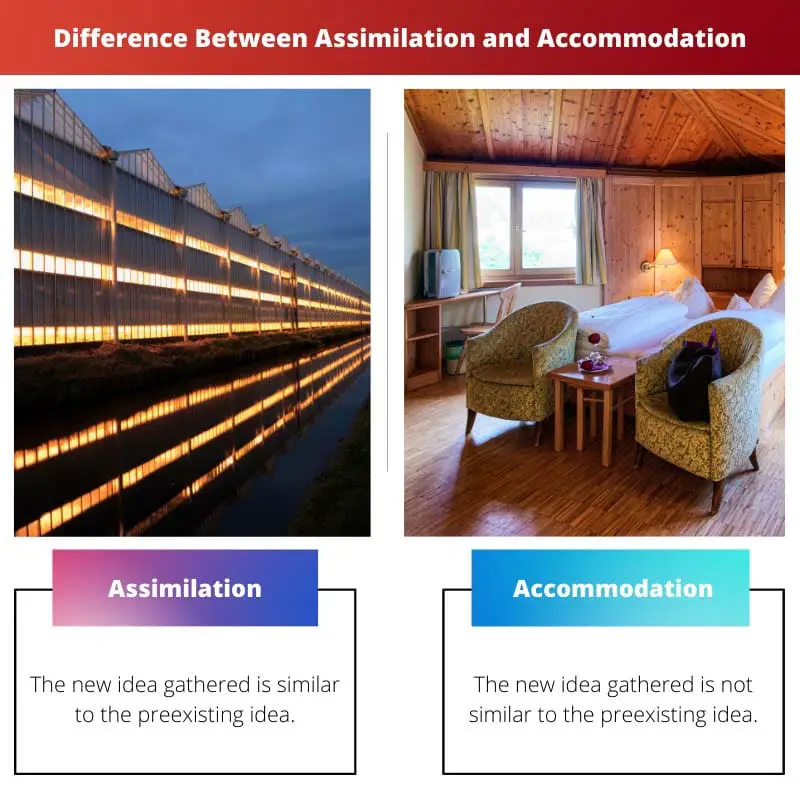Understanding how the human mind learns new things and retains that knowledge from infancy to adulthood that helps him or her perceive and orderly react to every situation is a matter of speculation.
Jean Piaget stated that intellectual growth takes place by adaptation to the environment by the above-stated two factors.
Key Takeaways
- Assimilation is the process of integrating new information into existing cognitive structures, while accommodation is the process of modifying cognitive structures to fit new information.
- Assimilation maintains cognitive equilibrium by fitting new experiences into pre-existing schemas, while accommodation creates or alters existing schemas.
- Both processes are essential for learning, with assimilation promoting understanding and accommodation allowing for cognitive growth.
Assimilation vs Accommodation
Assimilation of knowledge occurs when a learner encounters a new idea and must fit that idea into what they already know, and accommodation of knowledge is more substantial, requiring the learner to reshape those containers. The former is the use of a schema, while the latter is the creation of new schemas.

Assimilation is the process of learning about the environment in which the already set idea about something called the schema is not changed but rather modified with the addition of new additional information about that thing.
Usually, assimilation takes place over a long period and through experience.
Accommodation is the process of learning about the environment in which the already set idea about something called the schema is changed completely due to a contradiction between the existing and newly acquired ideas about the object in consideration.
It is a fast process and involves decision-making.
Comparison Table
| Parameters of Comparison | Assimilation | Accommodation |
|---|---|---|
| New Idea | The new idea gathered is similar to the preexisting idea. | The new idea gathered is not similar to the preexisting idea. |
| Schema | The preexisting schema is not changed. | The preexisting schema is completely changed. |
| Time of Adaptation | This is a slow and gradual process. | This is the result of a fast decision. |
| Result of | This is the result of gathering new information about a subject after accommodation. | This is a result of a conflict with the new and old ideas. |
| Nature of process | It is a subjective process. | It is not a subjective process. |
What is Assimilation?
Jean Piaget, in his theory of cognitive development, explains that an infant learns new things by adapting to new situations. This adaptation is twofold. The first is assimilation.
Assimilation is the process of stacking new ideas over old ones such that they correlate with each other.
It is a gradual process of learning by experience and gathering information little by little to shape an outlook on a subject.
There is no change entirely in the schema, but modifications take place on every encounter with the subject unless an entire picture of it is farmed in mind for proper response.
It starts with accommodation but continues in a different method, unconsciously, as the modifications taking place in our minds are out of our voluntary control.
Moreover, the process is subjective as the green of modifications and the need for response to the same stimuli is different for different people.
For e.g., if a person sees a dog, he knows that a four-legged animal is called a dog. He then, on the second encounter with the dog, notices that it has a tail and pointed snout.
On another occasion, it realizes the dog is a canine. Upon regular encounters, he assembles the whole picture of a dog, which helps him recognize a dog every time he sees one.

What is Accommodation?
Accommodation is the complementary process of learning to assimilation. It is a process by which a new idea is placed in the mind of the subject about something replacing an old idea.
Together with assimilation, it forms the basis of learning adaptation in infants and growing children up till adulthood.
It is a quick process of analyzing a piece of contradictive information and comparison with the already known information to reject the old idea and replace it with the new one to better fit into the response system of a person.
Thus it is evident that the preexisting schema of the mind changes completely to make way for the new idea.
It is a conscious effort made by a person, unlike assimilation, which is not controlled by any individual. It is also not subjective as these kinds of situations arise due to contradictions that are universally present.
For e.g., A person sees a dog and remembers it as a four-legged animal.
On another occasion, it sees another four-legged animal, the cat, and correlates it with the dog; however, since they are not similar, he has to make changes in his schema to accommodate a new four-legged animal called the cat.

Main Differences Between Assimilation and Accommodation
- A new idea in assimilation is similar to the old one and is correlated, while in accommodation, the new idea is contradictory to the old one.
- In assimilation, the mental schema is not replaced completely, while in accommodation, the schema is replaced completely with a new one.
- Assimilation is a matter of experience and failure, while accommodation deals with decision-making.
- In assimilation, no new information is completely rejected, while in accommodation, rejection of an idea is the basis of learning something new.
- Assimilation as a whole is a more laid-back learning process, whereas accommodation is chaotic and brings about questions and doubts.



